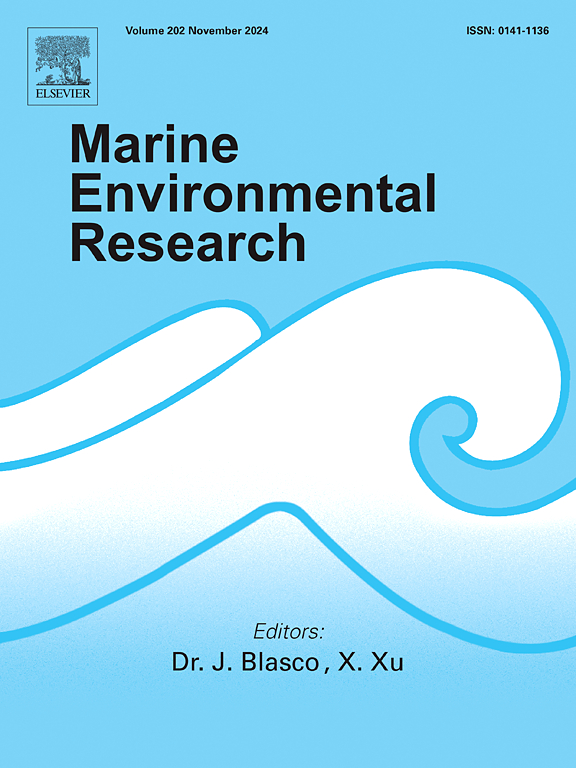Temporal variability in environmental influences on silver croaker (Pennahia argentata) life-history traits in the East China Sea
IF 3.2
3区 环境科学与生态学
Q2 ENVIRONMENTAL SCIENCES
引用次数: 0
Abstract
Climate change is reshaping marine ecosystems, yet its effects on the life-history traits of commercially important fish species remain insufficiently understood. This study investigates the impact of environmental factors on the growth and survival of silver croaker (Pennahia argentata) in the southern waters of Zhejiang, China, a key fishing ground in the East China Sea. A Life-History Trait Composite Index (LTCI), incorporating von Bertalanffy growth rate (K), mortality (M), average length (L), and asymptotic length (L∞), was used to assess responses to sea surface temperature (SST), sea surface salinity (SSS), dissolved oxygen (DO), and pH across three zones (South, Central, North) from 2015 to 2022. Analyses using Spearman correlation, cross-correlation functions (CCF), Generalized Additive Models (GAM), and Artificial Neural Networks (ANN) revealed zone-specific environmental drivers. pH and SSS emerged as primary influences: pH showed a strong positive correlation with LTCI in the South Zone (r = 0.79) and a moderate effect in the Central Zone (r = 0.44), while SSS had a strong negative impact in the South (r = −0.86) and moderate impact in the Central Zone (r = −0.25). Spearman results also showed contrasting SSS-LTCI correlations, ranging from strongly negative in the South (ρ = −0.89) to positive in the North (ρ = 0.37). GAMs identified nonlinear environmental effects, with SST exerting a significant negative influence in the Central Zone (p = 0.009) and pH having a positive effect (p = 0.046). In the North Zone, delayed oxygen stress and high sea surface salinity corresponded to a 47 % decline in fish size. These results underscore the importance of continuous ecosystem monitoring and highlight pH, DO, and SSS as critical drivers of silver croaker productivity. Region-specific management strategies are recommended: habitat conservation in the South, sea surface salinity and oxygen monitoring in the North, and threshold-based protections in the Central Zone to support sustainable fisheries.
环境对东海银鱼生活史特征影响的时间变异性
气候变化正在重塑海洋生态系统,但其对具有重要商业价值的鱼类生命史特征的影响仍未得到充分了解。本文研究了东海主要渔场浙江南部海域环境因子对阿根廷银鱼(Pennahia argentata)生长和生存的影响。采用结合von Bertalanffy生长率(K)、死亡率(M)、平均长度(L)和渐近长度(L∞)的生活史特征复合指数(LTCI),评估了2015 - 2022年3个区域(南、中、北)对海面温度(SST)、海面盐度(SSS)、溶解氧(DO)和pH的响应。利用Spearman相关、互相关函数(cross-correlation functions, CCF)、广义可加模型(Generalized Additive Models, GAM)和人工神经网络(Artificial Neural Networks, ANN)分析揭示了区域特异性环境驱动因素。pH和SSS是主要影响因素:pH与南区的LTCI呈强正相关(r = 0.79),中央区的影响中等(r = 0.44),而SSS对南区的影响较强(r = - 0.86),对中央区的影响中等(r = - 0.25)。Spearman的结果还显示了ssss - ltci相关性的对比,从南部的强烈负相关(ρ = - 0.89)到北部的正相关(ρ = 0.37)。GAMs发现了非线性环境效应,海温对中央区有显著的负影响(p = 0.009), pH对中央区有显著的正影响(p = 0.046)。在北部地区,延迟的氧胁迫和高海面盐度导致鱼类尺寸下降47%。这些结果强调了持续生态系统监测的重要性,并强调了pH、DO和SSS是银鱼生产力的关键驱动因素。建议采取特定区域的管理战略:在南部保护栖息地,在北部监测海面盐度和氧气,在中部地区进行基于阈值的保护,以支持可持续渔业。
本文章由计算机程序翻译,如有差异,请以英文原文为准。
求助全文
约1分钟内获得全文
求助全文
来源期刊

Marine environmental research
环境科学-毒理学
CiteScore
5.90
自引率
3.00%
发文量
217
审稿时长
46 days
期刊介绍:
Marine Environmental Research publishes original research papers on chemical, physical, and biological interactions in the oceans and coastal waters. The journal serves as a forum for new information on biology, chemistry, and toxicology and syntheses that advance understanding of marine environmental processes.
Submission of multidisciplinary studies is encouraged. Studies that utilize experimental approaches to clarify the roles of anthropogenic and natural causes of changes in marine ecosystems are especially welcome, as are those studies that represent new developments of a theoretical or conceptual aspect of marine science. All papers published in this journal are reviewed by qualified peers prior to acceptance and publication. Examples of topics considered to be appropriate for the journal include, but are not limited to, the following:
– The extent, persistence, and consequences of change and the recovery from such change in natural marine systems
– The biochemical, physiological, and ecological consequences of contaminants to marine organisms and ecosystems
– The biogeochemistry of naturally occurring and anthropogenic substances
– Models that describe and predict the above processes
– Monitoring studies, to the extent that their results provide new information on functional processes
– Methodological papers describing improved quantitative techniques for the marine sciences.
 求助内容:
求助内容: 应助结果提醒方式:
应助结果提醒方式:


